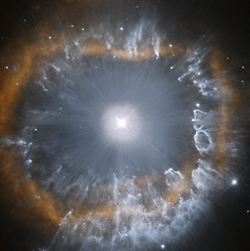りゅうこつ座AG星
| りゅうこつ座AG星 AG Carinae | ||
|---|---|---|

| ||
ハッブル宇宙望遠鏡が撮影したりゅうこつ座AG星
| ||
| 星座 | りゅうこつ座 | |
| 見かけの等級 (mv) | 6.0 - 8.1[1] | |
| 変光星型 | かじき座S型[2] | |
| 位置 元期:J2000.0 | ||
| 赤経 (RA, α) | 10h 56m 11.5779283438s[3] | |
| 赤緯 (Dec, δ) | −60° 27′ 12.809532379″[3] | |
| 視線速度 (Rv) | -54.0 km/s[3] | |
| 固有運動 (μ) | 赤経: -4.701 ミリ秒/年[3] 赤緯: 1.873 ミリ秒/年[3] | |
| 年周視差 (π) | 0.1532 ± 0.0291ミリ秒[3] (誤差19%) | |
| 距離 | 2万光年[注 1] (6 ± 1 キロパーセク[4]) | |
| 絶対等級 (MV) | -7.7 - -9.8[5] | |
| 物理的性質 | ||
| 半径 | 50(極小) - 500(極大) R☉[6] | |
| 質量 | 60 - 70 M☉[7] | |
| 自転速度 | 220 ± 50 km/s (1985-1990)[7] | |
| 自転周期 | 13 ± 2 日 (1985-1990)[7] | |
| スペクトル分類 | A(極大)[6] WN9 - 11[8] | |
| 光度 | 1.5 ×106 L☉[7] | |
| 表面温度 | 8,000(極大) - 26,000(極小) K[6] | |
| 色指数 (B-V) | 0.540[9] | |
| 色指数 (V-I) | 0.61[9] | |
| 他のカタログでの名称 | ||
| HD 94910, CD-59 3430, CPD-59 2860, Hen 3-528, HIP 53461, SAO 251185, WR 31b. | ||
| ■Template (■ノート ■解説) ■Project | ||
りゅうこつ座AG星(りゅうこつざAGせい、AG Carinae 、AG Car)は、りゅうこつ座の恒星である。高光度青色変光星(LBV)に分類される変光星で、銀河系の中で最も光度の大きい恒星の1つとされる。太陽系からの距離はおよそ2万光年と遠く、通常は肉眼で観測することができない明るさである[10][4]。見かけの等級は、6.0から8.1まで不規則に変化する[1]。
変光
[編集]
りゅうこつ座AG星は、1914年にハリー・ウッドによって、変光している可能性があることが発見された[11]。その後、ハーヴァード大学天文台の写真乾板から、半世紀近い測光結果をまとめたところ、不規則に変光する変光星であることが確かめられた[12]。変光星の分類は、アニー・ジャンプ・キャノンがスペクトルから、はくちょう座P星と似た天体であることを早くから指摘し、最終的にLBVであるとされた[13][10]。LBVは、大質量星がウォルフ・ライエ星へと進化する途中の短い段階と考えられている[14]。
りゅうこつ座AG星は、LBVの典型とされる[6]。それは、光度が太陽の100万倍を超える高光度[7]、スペクトル型がO型からA型に分布する青色[8]、最大で幅2等級にも及ぶ変光[1]、加えて窒素過剰な星周星雲の存在と[15]、LBVの条件を全て高水準で備えており、しかも、典型的には7等星と見かけの等級がLBVの中ではかなり明るく且つ、はくちょう座P星と異なり現在でも活動的で、りゅうこつ座η星のように特殊でもないからである[16][6]。
りゅうこつ座AG星は、LBV(変光星分類ではかじき座S型)に特徴的な2種類の変光を示す。長期的な変光は、10年単位の尺度で通常1等級、大きいときは2等級近く変化する。短期的な変光は、およそ1年の比較的安定した周期で、0.1等から0.5等変化する。この2種類の変光は、重複して生じる。また、主に光度極小期にみられる微小な変光もあり、2週間程度の周期で0.1等程度変動し、これははくちょう座α型の変光と似ている[1][5]。
明るさの変化に伴い、りゅうこつ座AG星のスペクトルも変化する。長期的変光の極小期には、ウォルフ・ライエ星のスペクトルを示し、極大期には、早期の(高温の)A型超巨星のスペクトルを示す[8]。これは、星の大きさと表面温度が変化していることを意味し、例えば1989年から1999年にかけての継続観測中に迎えた極小期、極大期では、半径が太陽の50倍から500倍まで、表面温度が26,000Kから8,000Kまで、それぞれ変化したとみられる[6]。LBVの場合、多くは変光に伴って放射光度が大きく変化することはない。りゅうこつ座AG星の場合は、光度の変化が観測されているが、これは誤差の範囲に収まる程度のものである[8]。
星雲
[編集]
1950年、ラドクリフ天文台での観測から、サッカレーはりゅうこつ座AG星の周りに楕円形の星雲状構造があることを発見した[18]。この星雲は、この1万年以内に中心星から大規模な質量放出が起きた結果形成されたものと考えられ、平均して70km/sの速さで膨張している[19][20]。また、楕円の短軸方向に沿って、ジェット状の双極構造があることもわかっている[20]。赤外線では、熱い塵から放射される近赤外線はほとんどみられず、恒星風により一掃されていると考えられるが、より長い波長の赤外線で、低温の塵の分布を調べると、可視光でみた星雲状構造と整合するような殻状の分布を示すが、もう少し円に近い形状をしている[21][16]。電波でも、同じような分布を示す[22]。
りゅうこつ座AG星を取り巻く星雲の組成を調べると、窒素が過剰に存在し、酸素は欠乏している。この傾向は、内部の核融合反応がCNOサイクルとなっている恒星から放出された物質であることと辻褄が合うが、LBVで予想されるCNO平衡状態を仮定した場合よりも、窒素の過剰も酸素の欠乏も低水準である。これは、りゅうこつ座AG星で大規模な質量放出が起きたのが、まだLBVへ進化する前の段階であったことを示唆する[15]。また、可視光での観測から推定した星雲のガスの質量は、太陽の4.2倍程度である一方、赤外線から見積もった塵の質量は太陽の0.2倍程度となっている[20][23]。一般的なLBVの星周物質における、ガスと塵の存在比を当てはめると、塵の質量が太陽の0.2倍程度なら、ガスは太陽の15倍程度の質量と予想され、観測から求めたガスの質量との間に矛盾が生じる。このことも、りゅうこつ座AG星で質量放出が起きたのが、LBV段階ではないことの証拠の一つとみられる[23]。
脚注
[編集]注釈
[編集]出典
[編集]- ^ a b c d van Genderen, A. M.; Sterken, C.; de Groot, M. (1997-02), “New discoveries on the S DOR phenomenon based on an investigation of the photometric history of the variables AG Car, S Dor and η Car”, Astronomy & Astrophysics 318: 81-98, Bibcode: 1997A&A...318...81V
- ^ Samus, N. N.; et al. (2009-01), “General Catalogue of Variable Stars”, VizieR On-line Data Catalog: B/gcvs, Bibcode: 2009yCat....102025S
- ^ a b c d e f “AG Car -- Wolf-Rayet Star”. SIMBAD. CDS. 2019年12月5日閲覧。
- ^ a b Humphreys, Roberta M.; et al. (1989-07), “The distance and evolutionary phase of the luminous blue variable AG Car”, Astronomy & Astrophysics 217: L17-L20, Bibcode: 1989A&A...218L..17H
- ^ a b van Genderen, A. M. (2001-02), “S Doradus variables in the Galaxy and the Magellanic Clouds”, Astronomy & Astrophysics 366: 508-531, Bibcode: 2001A&A...366..508V, doi:10.1051/0004-6361:20000022
- ^ a b c d e f Stahl, O.; et al. (2001-08), “Long-term spectroscopic monitoring of the Luminous Blue Variable AG Carinae”, Astronomy & Astrophysics 375: 54-69, Bibcode: 2001A&A...375...54S, doi:10.1051/0004-6361:20010824
- ^ a b c d e Groh, J. H.; Hillier, D. J.; Damineli, A. (2011-07), “On the Nature of the Prototype Luminous Blue Variable AG Carinae. II. Witnessing a Massive Star Evolving Close to the Eddington and Bistability Limits”, Astrophysical Journal 736 (1): 46, Bibcode: 2011ApJ...736...46G, doi:10.1088/0004-637X/736/1/46
- ^ a b c d Groh, J. H.; et al. (2009-06), “On the Nature of the Prototype Luminous Blue Variable AG Carinae. I. Fundamental Parameters During Visual Minimum Phases and Changes in the Bolometric Luminosity During the S-Dor Cycle”, Astrophysical Journal 698 (2): 1698-1720, Bibcode: 2009ApJ...698.1698G, doi:10.1088/0004-637X/698/2/1698
- ^ a b ESA (1997), The HIPPARCOS and TYCHO catalogues. Astrometric and photometric star catalogues derived from the ESA HIPPARCOS Space Astrometry Mission, ESA SP Series, 1200, Noordwijk, Netherlands: ESA Publications Division, Bibcode: 1997ESASP1200.....E, ISBN 9290923997
- ^ a b Humphreys, Roberta M. (1989), “What are LBV’s? — Their Characteristics and Role in the Upper H-R Diagram”, Astrophysics and Space Science Library 157: 3-14, Bibcode: 1989ASSL..157....3H, doi:10.1007/978-94-009-1031-7_1
- ^ Wood, H. E. (1914-06), “Discovery of a variable star in Carina”, Monthly Notices of the Royal Astronomical Society 74: 698, Bibcode: 1914MNRAS..74..698W, doi:10.1093/mnras/74.8.698
- ^ Greenstein, Naomi K. (1938-03), “Four Irregular Variables, AG, T, GG, and ES Carinae”, Harvard College Observatory Bulletin 908: 25-29, Bibcode: 1938BHarO.908...25G
- ^ Cannon, Annie Jump; Pickering, Edward Charles (1916), “Spectra having bright lines”, Annals of the Astronomical Observatory of Harvard College 76 (3): 19-42, Bibcode: 1916AnHar..76...19C
- ^ Humphreys, Roberta M.; Davidson, Kris (1994-10), “The Luminous Blue Variables: Astrophysical Geysers”, Publications of the Astronomical Society of the Pacific 106 (704): 1025-1051, Bibcode: 1994PASP..106.1025H, doi:10.1086/133478
- ^ a b Smith, L. J.; et al. (1997-09), “The AG Carinae nebula: abundant evidence for a red supergiant progenitor?”, Monthly Notices of the Royal Astronomical Society 290 (2): 265-275, Bibcode: 1997MNRAS.290..265S, doi:10.1093/mnras/290.2.265
- ^ a b Voors, R. H. M.; et al. (2000-04), “Infrared imaging and spectroscopy of the Luminous Blue Variables Wra 751 and AG Car”, Astronomy & Astrophysics 351: 501-516, Bibcode: 2000A&A...356..501V
- ^ “Snapshot of a shedding star”. Hubble Space Telescope. ESA (2014年9月29日). 2019年12月7日閲覧。
- ^ Thackeray, A. D. (1950), “Some southern stars involved in nebulosity”, Monthly Notices of the Royal Astronomical Society 110: 524-530, Bibcode: 1950MNRAS.110..524T, doi:10.1093/mnras/110.6.524
- ^ Stahl, O. (1987-08), “Direct imagery of circumstellar shells around Ofpe/WN 9 stars in the galaxy and in LMC”, Astronomy & Astrophysics 182: 229-236, Bibcode: 1987A&A...182..229S
- ^ a b c Nota, Antonella; et al. (1992-10), “Mapping AG Carinae: Long-Slit Spectroscopy and Coronographic Imaging of the Nebula and Jet”, Astrophysical Journal 398: 621-631, Bibcode: 1992ApJ...398..621N, doi:10.1086/171887
- ^ Nota, A.; et al. (2002-11), “Detection of 12CO J=1-->0 and J=2-->1 Emission from the Luminous Blue Variable AG Carinae: Circumstellar Envelope or Disk?”, Astronomical Journal 124 (5): 2920-2930, Bibcode: 2002AJ....124.2920N, doi:10.1086/343770
- ^ Duncan, R. A.; White, S. M. (2002-02), “Radio images of four luminous blue variable stars”, Monthly Notices of the Royal Astronomical Society 330 (1): 63-68, Bibcode: 2002MNRAS.330...63D, doi:10.1046/j.1365-8711.2002.05034.x
- ^ a b Vamvatira-Nakou, C.; et al. (2015-06), “The Herschel view of the nebula around the luminous blue variable star AG Carinae”, Astronomy & Astrophysics 578: A108, Bibcode: 2015A&A...578A.108V, doi:10.1051/0004-6361/201425090
関連項目
[編集]外部リンク
[編集]- “VSX: Detail for AG Car”. AAVSO (2012年9月11日). 2019年12月6日閲覧。
- Shedding star - ESA
- 2MASS Atlas Image Gallery: Miscellaneous Objects
- Big and Giant Stars: AG Carinae